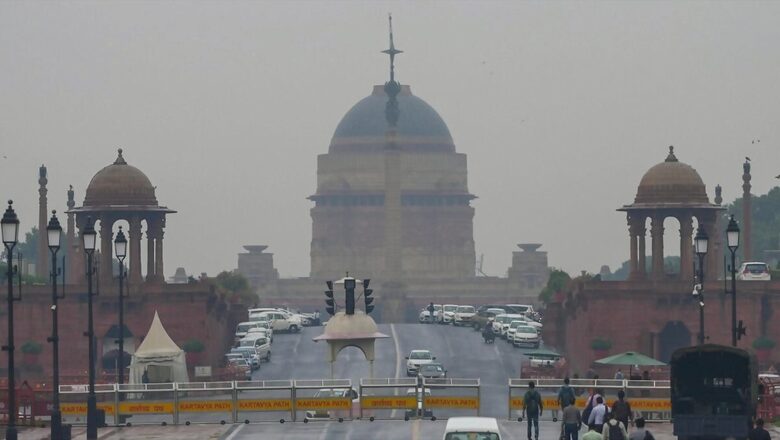
views
Delhi environment minister Gopal Rai laughed off suggestions that the light showers in Delhi on Friday morning, which brought relief from hazardous air quality, had anything to do with the artificial rain initiative that the government is planning to put in place. He said numerous permissions are required to implement the project, which has been devised by IIT-Kanpur scientists.
“A number of permissions are required for artificial rain. It cannot be done in a day. We have presented the proposal in front of the Supreme Court. Once the court approves, we will then make preparations so that it can be induced if and when needed,” Rai told NDTV.
Rai further said the government is monitoring how long the impact of the rains last in Delhi. “…an improvement is seen in the pollution level. The AQI, which was above 450, has now reached around 300. The decision to implement odd-even from November 13 to 20 has been postponed. The situation will be analysed again after Diwali…” he added.
There was much social media chatter about the intermittent rain in Delhi that led to a rapid improvement in the air quality and cleared the suffocating haze lingering for more than 10 days. At 1 pm, Delhi’s air quality index (AQI) stood at 314, which falls in the “very poor” category. It was 376 at 9 am and 408 at 7 am. The AQI was 460 at 11 pm on Thursday (November 9). The AQI at any given time is the average of readings taken in the last 24 hours.
According to India Meteorological Department (IMD), the air quality is expected to improve further due to wind speed, which is favourable for the dispersion of pollutants. The Safdarjung observatory, Delhi’s primary weather station, recorded 6 mm of rainfall in 24 hours ending 8.30 am on Friday and 2.2 mm between 8.30 am and 11.30 am, said the MeT.
The IMD had earlier predicted a marginal improvement in the air quality just ahead of Diwali owing to favourable meteorological conditions, including light rain. Officials had also said a change in the wind direction from northwest to southeast due to a fresh western disturbance affecting northwest India will help reduce the contribution of smoke from stubble burning. Once the western disturbance passes, the wind speed will increase to around 15 kmph on Saturday (November 11), which will help disperse pollutants ahead of Diwali (November 12).
Last year, a decrease in stubble-burning incidents, delayed spells of rain and an early Diwali along with favourable meteorological conditions prevented the national capital from turning into a gas chamber following the festival.
The Delhi government was, however, rapped by the Supreme Court that was hearing a bunch of petitions on the worsening air quality in Delhi. It told the government to perform its duty and not shift the burden onto the court in decisions linked to measures to reduce pollution in the city.
On a lighter note, the bench headed by Justice Sanjay Kishan Kaul congratulated the government on the rain, which had helped bring relief from the toxic air conditions. “On the lighter side, what the population has to do is to pray only,” Justice Kaul said, adding that sometimes rains come and that helps.
If Centre gives nod, first phase of artificial rain by Nov 20
Artificial rain through cloud seeding involves dispersing substances into the air to encourage condensation, resulting in precipitation. The most common substances used for cloud seeding include silver iodide, potassium iodide and dry ice (solid carbon dioxide). These agents provide the nuclei around which water vapour can condense, ultimately leading to the formation of rain or snow.
This weather modification technique has been utilised in various parts of the world, primarily in regions experiencing water scarcity or drought conditions.
The IIT-Kanpur team claimed that successful trials of artificial rain have been carried out in Kanpur, resulting in success in six out of seven attempts. They further confirmed the prima facie feasibility of trying out the technology in Delhi during winter to reduce air pollution levels.
The Delhi government has decided to bear the entire cost of artificial rain to combat hazardous air pollution. If the Centre supports the decision, the first phase of artificial rain in the city will be implemented by November 20.
“In a significant development, the Delhi government has decided to bear the cost of artificial rain that could be made to happen by November 20 if the Centre extends its support to the Delhi government,” said a senior government functionary.
“…the Delhi government has in principle agreed, based on the advice of an IIT-Kanpur team, to bear the cost of Phase 1 and Phase 2 pilots (totalling Rs 13 crore) for carrying out artificial rain,” the government functionary said.
Permissions required, plan, cost breakdown of the project
Here is all you need to know about how the project will be implemented:
- According to the IIT-Kanpur team, permissions from 10 central government ministries and agencies as well as the Uttar Pradesh government will be required to induce artificial rain.
- The team estimated that the cost of the project will be around Rs 1 lakh per sq km. It recommended that a pilot cloud seeding initiative covering 300 sq km may be carried out immediately in the first phase, given the air pollution emergency prevailing in Delhi.
- Artificial cloud seeding will depend on four factors – clouds with moisture (minimum 40 percent content), aircraft and setup, seeding material and permissions.
- Experts from IIT-Kanpur have also advised that, as per current meteorological predictions, sufficient clouds over Delhi will be available around November 20 and 21 and they would be willing to carry out the first phase of the cloud seeding attempt during those days.
- Chief secretary Naresh Kumar has been directed to coordinate with the IIT-Kanpur team and the central ministries as well as agencies for the project and submit the proposal for artificial rain before the Supreme Court through an affidavit.
(With PTI inputs)

















Comments
0 comment